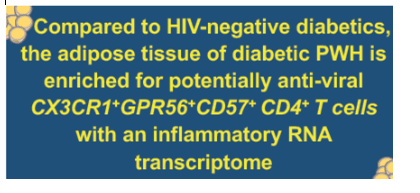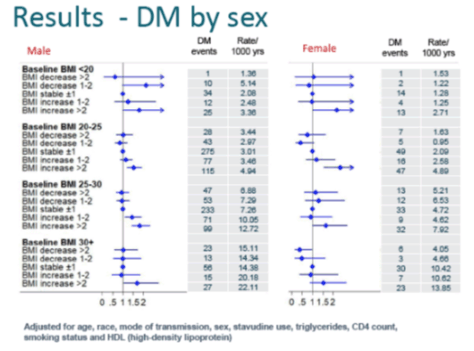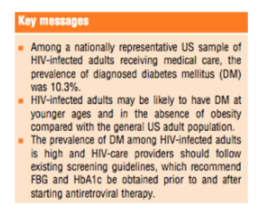 |
 |
 |
| |
INCREASED INFLAMMATORY CX3CR1+GPR56+CD57+ CD4+ T CELLS IN FAT FROM HIV+ DIABETICS
|
| |
| |
CROI 2020
Reported by Jules Levin
Celestine N. Wanjalla1,2, Wyatt J. McDonnell 9, Ramesh Ram8, Abha Chopra8, Rama Gangula3, Shay Leary8, Beverly O. Woodward1,3, Mark A. Pilkinton1,2, Mona Mashayekhi4, Samuel Bailin1, Curtis L. Gabriel6, Alyssa M. Hasty7, Simon A. Mallal1-3, ,5,8, Spyros A. Kalams1-3, John R. Koethe1-3
1 Division of Infectious Diseases, 2 Center for Translational Immunology and Infectious Disease, 3 Tennessee Center for AIDS Research, 4 Division of Diabetes, Endocrinology and Metabolism, 5 VANTAGE, Vanderbilt University Medical Center, 6 Division of Gastroenterology, Hepatology and Nutrition, Vanderbilt University Medical Center7 Department of Molecular Physiology and Biophysics, Vanderbilt University, Nashville, TN, USA6 8 Institute for Immunology and Infectious Diseases, Murdoch University, Perth, WA, Australia , 910X Genomics, Pleasanton, CA, USA
[ HIV+ are at risk for developing diabetes at they age with rates of diabetes in older HIV+ higher than in younger HIV+ & HIV-negs. HIV+ with diabetes appear to have disrupted fat tissue metabolism. Diabetes is associated with mortality & decreased quality of life, as it progresses it can be difficult to manage. There appears to be a difference in the affect of diabetes in HIV+ vs HIV- that may results in worse metabolic overall outcomes. Jules]

--------------------------------
CROI 2020:
Adipocyte Dysfunction Despite Reduced Adipose
Inflammation in Diabetics with HIV.....
http://www.natap.org/2020/CROI/croi_165.htm
In one of the largest and broadest assessments of adipose tissue gene expression in non-diabetic vs. diabetic PWH on modern ART, we found pronounced differences in adipocyte-related genes, consistent with dysregulation of metabolic pathways in diabetes.....78% of study participants were male. The median age was 45 years and 55 years, and median BMI 31 kg/m2 and 34 kg/m2, for non-diabetic and diabetic participants, respectively. Analysis of adipocyte-related genes revealed that diabetic individuals had lower expression of genes involved in the AMPK signaling (FASN, PPARG, PCK2) and fatty acid biosynthesis (FASN, ACSL6) pathways, and increased expression of genes involved in fatty acid degradation (ACOX1, ACSL3) (FDR-adjusted p value < 0.05; Figure 1)
Predicted 10-year risks of diabetes and
cardiovascular disease in the ADVANCE trial
http://www.natap.org/2020/CROI/croi_80.htm
Rising BMI Tied to Risk of Diabetes But Not CVD in D:A:D Analysis
http://www.natap.org/2020/CROI/croi_145.htm
Across all baseline BMI levels, more than a 2-kg/m2 BMI increase was consistently independently associated with a higher risk of diabetes. Among people in the overweight range at baseline (25 to 30 kg/m2), a BMI gain of 1-2 kg/m2 independently boosted diabetes risk. These associations held true for both men and women in every baseline BMI bracket: gaining more than 2 kg/m2 during follow-up magnified diabetes risk.

In the Kaiser Julia Marcus mortality & comorbidity free CROI study: diabetes in HIV-neg in current era begins at age 73 but in HIV+ 65, 9 years earlier one of diabetes in HIV+....
http://www.natap.org/2020/CROI/croi_36.htm

CROI 2020: Glucose Upsets Tied to Worse Physical Function in Men With or Without HIV
http://www.natap.org/2020/CROI/croi_18.htm
Abnormal glucose metabolism raised chances of slow gait speed and weak grip strength in HIV-positive and negative men in the Multicenter AIDS Cohort Study (MACS) [1]. Uncontrolled diabetes independently lowered grip strength in men with HIV regardless of viral load control. The study tied longer time taking antiretroviral therapy to stronger grip strength.
http://www.natap.org/2018/HIV/e000457.full.pdf
"For each 5 pounds of weight gained, HIV+ had 14% increased risk of DM (HR, 1.14”
http://www.natap.org/2018/HIV/050718_01.htm
Time since HIV diagnosis was significantly associated with a higher DM prevalence.....The unadjusted prevalence of DM (CI) among HIV-infected adults was 10.3% (9.1% to 11.5%), and was higher compared with the general US adult population (8.3% (7.2% to 9.4%)) as well as the general US adult population having received care in the previous 12 months (9.7% (8.4% to 11.1%)) (data not shown). Among HIV-infected adults with diagnosed DM, 3.9% (95% CI 2.9% to 5.2%) had DM type 1, 52.3% (CI 46.7% to 57.8%) had DM type 2, and 43.9% (CI 38.1% to 49.8%) had unspecified DM. After adjusting for differences in distributions of sex, age, race/ethnicity, education, poverty, obesity, and HCV infection prevalence, the adjusted PD (aPD) of DM in HIV-infected adults versus the general US adult population was 3.8% (table 2) [11.8 vs 8.0, among whites 11.4 vs 6.5, among blacks 13.1 vs 11.8]

http://www.natap.org/2017/HIV/020617_04.htm
Insulin Resistance/Diabetes and HIV and Hepatitis C; Aging/HIV & diabetes. by Judy Aberg.
http://www.natap.org/2004/CROI/croi_56.htm
These data suggest that diabetes is associated with decreased overall cognitive performance and specifically psychomotor performance in patients with HIV......DM was negatively associated with overall cognitive functioning (F = 19.15, p < 0.01), accounting for 11% of the variance in NPZ8 scores. DM was also negatively associated with psychomotor functioning (F = 14.16,pp < 0.01) accounting for 8% of the variance in NPZ3-psychomotor scores
---------------------------
CROI 2020
Reported by Jules Levin




|
| |
|
 |
 |
|
|